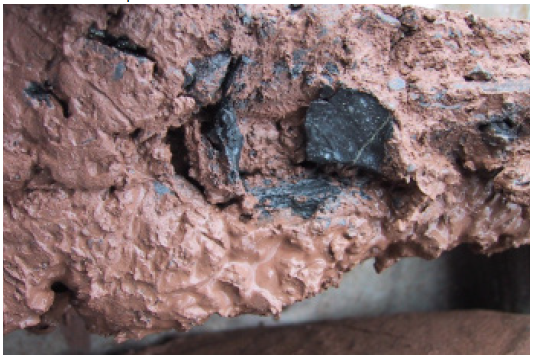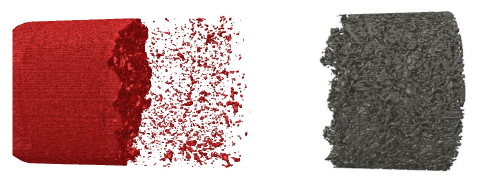The following is an article from Dr G Ward Wilson which appeared in the Paste 2023 Supplement
Commingling tailings and waste rock
By Dr G Ward Wilson, University of Alberta, Canada
Introduction
The practice of co-disposal for mine tailings and waste rock is becoming more and more popular. There are progressive degrees of codisposal, beginning with i) the deposition of tailings and rock into the same impoundment, ii) the deposition of waste rock into a tailings impoundment, iii) the case where tailings are added to the waste rock pile, and iv) the case where coarse and fine tailings are pumped to an impoundment together for co-disposal, otherwise known as pumped co-disposal (Wickland 2006). All of these methods, while shown to be feasible and relatively easy to implement, produce deposits where the fine tailings and coarse waste are segregated upon deposition.
Segregation often produces problematic deposits that lead to both chemical and physical instability. The problems associated with segregation for the co-disposal of tailings and waste rock can be resolved with a new practice best referred to as commingling.
The Merriam-Webster dictionary defines commingle as ‘to blend thoroughly into a harmonious whole.’ The word commingle is
a verb and is an antonym of the word segregate. Over the last 20 years, research has shown that commingling tailings and waste rock offers significant benefits. This article briefly highlights some of the basic theory and design principles for commingling tailings and waste rock, along with laboratory testing and field trials.
Basic theory and design principles
The Porgera Gold Mine, in Papua New Guinea, investigated the co-disposal of fine autoclaved gold tailings within its waste rock dumps (Wilson 2001). It was found that mixing the tailings, after dewatering and thickening, with the waste rock would
produce a new material with highly desirable characteristics.
Figure 1 shows an example of this new blended material that is referred to as commingled tailings and waste rock in this article. A variety of names have been used in the past, such as co-mix and paste rock, to describe this new material;
however, commingled tailings and waste rock is considered to be the most descriptive term.
The new commingled material in Figure 1 combines the physical attributes of both the waste rock and the tailings. It can be seen that the waste rock particles have clast-to-clast contact. Hence, the compressibility and shear strength of this material
remain similar to the waste rock. At the same time, the hydraulic properties of the tailings, including the saturated hydraulic conductivity (Ksat) and air entry value, are controlled by the tailings that fill the voids in the waste rock.

Figure 2 presents a computed tomography scan showing the voids (in red in left image) within a shale waste rock (shown in the right image). In short, these are the voids in the waste rock that are filled with tailings to produce the new commingled mixture. The volume and pore size distribution of these voids control the blending ratio and physical behaviour of the commingled material.
Wickland (2006) provides a comprehensive and theoretical framework for describing the phase relationships, volume change and permeability of mixtures of tailings and waste rock. Wickland (2006) specifies design criteria to determine the blend ratio of tailings and waste rock such that the voids within the waste rock are completely filled with tailings while maintaining clast-to-clast contact within the matrix of the waste rock. This blend ratio is referred to as the just filled blend. The primary properties of the tailings and the waste rock, which control the blend ratio and behaviour of the mixture, are i) grain-size distributions of the tailings and waste rock, ii) porosity and water content of the waste rock, iii) solids content of the tailings, iv) specific gravity of each material, and v) in situ stress and final density of the mixture.

Laboratory testing and field trials
The field trial conducted at the Porgera Gold Mine led to the development of a major research program under a Strategic Partnership Grant funded by the Natural Sciences and Engineering Research Council of Canada and supported by Placer Dome Inc., INCO, Klohn Crippen Berger and Golder Associates Ltd. Wickland (2006) describes a meso scale experiment with four 6 m high columns constructed to measure the performance of the mixtures for tailings and waste rock.
In addition, five large field lysimeter trials were installed at Copper Cliff Mine, Ontario (Figure 3). Commingled mixtures of tailings, waste rock and slag to produce barrier cover systems to limit infiltration and to control acid rock drainage were placed in these lysimeters. The results of the field study showed that the annual amount of infiltration of snowmelt and rainfall for the uncovered beach tailings decreased from about 500 mm/year to approximately 100 mm/year for a 1 m thick non-compacted commingled cover and to values approaching 10 mm/year for a 300 mm thick compacted commingled barrier cover.
Furthermore, the pH was seen to increase from approximately 3.5 to values approaching 6 for all commingled covers profiles.
Wilson et al. (2008) summarise the research programs completed at both the Porgera Gold Mine and the Copper Cliff Mine.

Most recently Ralph Burden (2021) completed a PhD thesis directed at achieving stable dry-stacked tailings using blended tailings and waste rock. Burden et al. (2019) showed how the properties of filtered tailings can be improved for dry stacking by commingling the filter tailings with waste rock.
Figure 4 shows the slurry (or dynamic) consolidometer at The University of Queensland, in Australia, made available by
David Williams who served as co-supervisor for Burden’s PhD research program. The dynamic consolidometer is 400 mm high and allows vertical stress and loading rates to be applied to a tailings profile at a constant rate with direct measurements of deformation and porewater pressure development in the column of tailings. In the case of unsaturated filtered tailings for dry stacking, the development of positive porewater pressures will reduce stability.

Figure 5 shows porewater pressure at the base of the profile during loading for filtered tailings and commingled filtered tailings, blended with waste rock at ratios of 1:1 rock to tailings and 1.8:1 rock to tailings (based on dry mass). Figure 5 shows that significant porewater pressure can develop within the unsaturated profile of filtered tailings during loading that can lead to significant reductions in shear strength with the potential for liquefaction to develop. The figure also shows that commingling waste rock with filtered tailings dramatically reduces the development of porewater pressures and thus indicates the stability of dry-stacked tailings systems can be enhanced by commingling with waste rock.
The examples described here for commingled tailings and waste rock are based on thickened/paste and filtered tailings.

However, commingling tailings and waste rock can be carried out with a wide variety of tailings. Figure 6 shows a dry stack of commingled sand and dredged waste rock near Dawson City, Yukon. In this case, the fine washed sand that typically flows off
the deck of the dredge was collected and deposited on top of the conveyor transporting the coarse cobble sized rock at the rear of the dredge. It is important to note that the sand and rock was well mixed for deposition with a relatively short conveyor of about 30 m, indicating that blending and commingling can be easily achieved with conveyor systems.

Summary
Interest in the mining industry to improve tailings and mine waste facilities is developing rapidly. There is a need to form mine waste facilities that are both geochemically and physically stable. Commingling of tailings and waste rock is a relatively new method that potentially offers significant benefits.
The commingling concept combines tailings and waste rock to a specified mix design ratio for deposition in a single repository. These two materials are blended to produce an engineered material with superior physical and hydraulic properties for the construction of post-mining landforms compared to the waste rock or tailings themselves. The commingled material has high strength, high density and low compressibility characteristics, similar to that of well-placed engineered waste rock piles. Furthermore, this new commingled material also has a hydraulic conductivity similar to tailings, with excellent water retention characteristics without loss in geotechnical strength. These properties of the commingled material restrict both oxygen entry and water seepage for the minimisation oxidation and metal leaching. Furthermore, the commingled material has a higher density than either conventional tailings or waste rock deposits, thus reducing the total footprint required for the storage when compared to conventional storage facilities for the management of tailings and waste rock.
References
Burden, R 2021, Using Codisposal Techniques to Achieve Stable “Dry-Stacked” Tailings: Geotechnical Properties of
Blended Waste Rock and Tailings in Oil Sands and Metal Mining, PhD thesis, Department of Civil & Environmental Engineering,
University of Alberta, Edmonton.
Burden, R, Williams, DJ, Wilson, GW & Jacobs, M 2019, ‘The geotechnical properties of filtered tailings and waste rock blends’, Proceedings of The 6th International Seminar on Tailings Management, Gecamin, Santiago.
Wickland, B 2006, Volume Change and Permeability of Mixtures of Waste Rock and Fine Tailings, PhD thesis, Department of Civil Engineering, The University of British Columbia, Vancouver.
Wilson, GW 2001, ‘Co-disposal of tailings and waste rock’, Geotechnical News, vol. 19, no. 2, pp. 44–49.
Wilson, GW, Wickland, B & Miskolczi, J 2008, ‘Design and performance of paste rock systems for mine waste management’, Proceedings of Rock Dumps 2008, Australian Centre for Geomechanics, Perth, pp. 107–116.

G Ward Wilson, University of
Alberta
